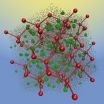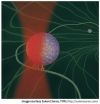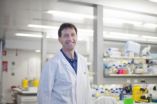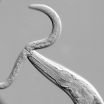(Press-News.org) This press release is available in German.
An international team of researchers from the MPI for Evolutionary Anthropology in Leipzig and the CNRS in Lyon have investigated the maternally inherited mitochondrial DNA of 500 individuals from southern Africa speaking different Khoisan and Bantu languages. Their results demonstrate that Khoisan foragers were genetically more diverse than previously known. Divergent mtDNA lineages from indigenous Khoisan groups were incorporated into the genepool of the immigrating Bantu-speaking agriculturalists through admixture, and have thus survived until the present day, although the Khoisan-speaking source populations themselves have become extinct.
The hunter-gatherer and pastoralist peoples of southern Africa who speak indigenous non-Bantu languages called Khoisan have intrigued researchers for a long time because their languages contain highly unusual click consonants and because they harbour some of the most deep-rooting genetic lineages in modern humans. Based on archaeological finds it is assumed that some of these Khoisan peoples are the descendants of indigenous Late Stone Age foragers, while peoples speaking Bantu languages immigrated into this area only 2,000-1,200 years ago.
From historical documents the Khoisan peoples were known predominantly in the area of what is now South Africa, Namibia, Botswana, southern Angola and bordering areas of southwestern Zambia. Genetic research has now found evidence that Khoisan peoples must have been settled further to the north in Zambia as well – but that these northern groups of Khoisan were genetically quite distinct from the Khoisan peoples known nowadays. By sequencing the complete mitochondrial genomes – which are inherited only in the maternal line - of 500 individuals speaking different Khoisan and Bantu languages from Botswana, Namibia, Zambia, and Angola, a team of researchers at the Max Planck Institute for Evolutionary Anthropology in Leipzig and the CNRS in Lyon, in collaboration with researchers from the University of Botswana and the University of Porto, have discovered divergent Khoisan mitochondrial DNA lineages in some Bantu-speaking groups predominantly from Zambia. These divergent lineages are nearly exclusively found in individuals speaking Bantu languages and are practically absent from any of the peoples speaking Khoisan languages.
"Our analyses indicate that the best explanation for our findings is that the Bantu-speaking immigrants married resident Khoisan women when they first came to southern Africa, thus incorporating these divergent lineages into their maternal genepool. The Khoisan peoples with whom they came into contact probably disappeared later on, since we do not find these divergent Khoisan lineages in any of the known Khoisan peoples," says Chiara Barbieri from the MPI for Evolutionary Anthropology and lead author of the study. "This is a really important finding, because it demonstrates that we might be able to learn more about the peoples who inhabited sub-Saharan Africa before the Iron Age spread of Bantu-speaking agriculturalists by studying relic lineages that were taken up by the agriculturalists through intermarriage with indigenous peoples," adds Brigitte Pakendorf from the CNRS lab Dynamique du Langage in Lyon, who coordinated the study.
INFORMATION:
Original publication:
Chiara Barbieri, Mário Vicente, Jorge Rocha, Sununguko W. Mpoloka, Mark Stoneking, Brigitte Pakendorf
Ancient substructure in early mtDNA lineages of southern Africa
American Journal of Human Genetics, February 7, 2013
Genetic admixture in southern Africa
Ancient Khoisan lineages survive in contemporary Bantu groups
2013-01-17
ELSE PRESS RELEASES FROM THIS DATE:
Study of cancer cell metabolism yields new insights on leukemia
2013-01-17
University of Rochester Medical Center scientists have proposed a new reason why acute myeloid leukemia, one of the most aggressive cancers, is so difficult to cure: a subset of cells that drive the disease appear to have a much slower metabolism than most other tumors cells.
The slower metabolism protects leukemia cells in many important ways and allows them to survive better – but the team also found an experimental drug tailored to this unique metabolic status and has begun testing its ability to attack the disease, URMC researchers report in the Jan. 17, 2013, online ...
Bacteria's hidden skill could pave way for stem cell treatments
2013-01-17
A discovery about the way in which bugs spread throughout the body could help to develop stem cell treatments.
Researchers at the University of Edinburgh have found that bacteria are able to change the make-up of supporting cells within the nerve system, called Schwann cells, so that they take on the properties of stem cells.
Because stem cells can develop into any of the different cell types in the body – including liver and brain cells – mimicking this process could aid research into a range of degenerative conditions.
Scientists made the discovery studying ...
RUB researchers find over active enzyme in failing hearts
2013-01-17
A certain enzyme, the CaM kinase II, keeps the cardiac muscle flexible. By transferring phosphate groups to the giant protein titin, it relaxes the muscle cells. This is reported by researchers led by Prof. Dr. Wolfgang Linke of the Institute of Physiology at the Ruhr Universität in the journal Circulation Research. In failing hearts, which don't pump enough blood around the body, the scientists found an overly active CaM kinase II. "The phosphorylation of titin could be a new starting point for the treatment of heart failure" Prof. Linke speculates.
Titin phosphorylation ...
Soft Lego built in the computer
2013-01-17
In developing these novel self-assembling materials, postdoc Barbara Capone has focused on the design of organic and inorganic building blocks, which are robust and can be produced at large scale. Capone has put forward, together with her colleagues at the Universities of Vienna and Mainz, a completely new pathway for the construction of building blocks at the nanoscale.
"Soft Lego" orders in crystal structures
The team of researchers has shown that so-called block copolymer stars – that means polymers that consist of two different blocks and they are chemically ...
Vaginal delivery is the safest option for women with pelvic girdle pain
2013-01-17
Caesarean section increases the risk of persistent pelvic girdle pain after delivery compared with vaginal delivery, according to a new study from the Norwegian Institute of Public Health.
Caesarean section rates are increasing worldwide, and this trend has partly been explained by women's requests for planned caesarean section without a medical reason. Pregnancy-related pelvic girdle pain has been associated with increased preference for caesarean section and with increased planned caesarean section rates.
"Some women with severe pelvic girdle pain might fear that ...
A nano-gear in a nano-motor inside you
2013-01-17
To live is to move. You strike to swat that irritable mosquito, which skilfully evades the hand of death. How did that happen? Who moved your hand, and what saved the mosquito? Enter the Molecular Motors, nanoscale protein-machines in the muscles of your hand and wings of the mosquito. You need these motors to swat mosquitoes, blink your eyes, walk, eat, drink... just name it. Millions of motors tug as a team within your muscles, and you swat the mosquito. This is teamwork at its exquisite best.
Paradoxically, a weak and inefficient motor (called dynein) is the one that ...
A hidden treasure in the Large Magellanic Cloud
2013-01-17
Nearly 200 000 light-years from Earth, the Large Magellanic Cloud, a satellite galaxy of the Milky Way, floats in space, in a long and slow dance around our galaxy. Vast clouds of gas within it slowly collapse to form new stars. In turn, these light up the gas clouds in a riot of colours, visible in this image from the NASA/ESA Hubble Space Telescope.
The Large Magellanic Cloud (LMC) is ablaze with star-forming regions. From the Tarantula Nebula, the brightest stellar nursery in our cosmic neighbourhood, to LHA 120-N 11, part of which is featured in this Hubble image, ...
Potential new treatment for gastrointestinal cancers discovered
2013-01-17
Researchers have identified a complex of proteins that promotes the growth of some types of colon and gastric cancers, and shown that medications that block the function of this complex have the potential to be developed into a new treatment for these diseases.
The complex of proteins, known as mTorc1 (mammalian target of rapamycin complex 1), has previously been implicated in the development of some other cancers but this is the first time it has been shown to promote the growth of colon and gastric cancers that are associated with inflammation.
Dr Stefan Thiem and ...
Amputations among people with diabetes can be reduced by 50 percent
2013-01-17
Every 30 seconds somebody in the world is amputated as a consequence of foot complication due to diabetes. A new study at Sahlgrenska Academy, University of Gothenburg, Sweden, confirmes that shoe inserts, podiatry, regular checkups and other simple interventions can reduce the number of amputations by more than 50%.
Orthotic researchers at Sahlgrenska Academy, University of Gothenburg, have studied diabetic foot complications ever since 2008. They have focused on protecting the foot from overloading the foot sole in order to minimize the risk of ulcers, which may eventually ...
The neurobiological consequence of predating or grazing
2013-01-17
This press release is available in German.
Researchers in the group of Ralf Sommer at the Max Planck Institute for Developmental Biology in Tuebingen, Germany, have for the first time been able to identify neuronal correlates of behaviour by comparing maps of synaptic connectivity, or "connectomes", between two species with different behaviour. They compared the pharyngeal nervous systems of two nematodes, the bacterial feeding Caenorhabditis elegans and the predator/omnivore Pristionchus pacificus and found large differences in how the neurons are "wired" together.
A ...
LAST 30 PRESS RELEASES:
Ticking time bomb: Some farmers report as many as 70 tick encounters over a 6-month period
Turning garden and crop waste into plastics
Scientists discover ‘platypus galaxies’ in the early universe
Seeing thyroid cancer in a new light: when AI meets label-free imaging in the operating room
Neutrophil-to-lymphocyte ratio may aid risk stratification in depressive disorder
2026 Seismological Society of America Annual Meeting
AI-powered ECG analysis offers promising path for early detection of chronic obstructive pulmonary disease, says Mount Sinai researchers
GIMM uncovers flaws in lab-grown heart cells and paves the way for improved treatments
Cracking the evolutionary code of sleep
Medications could help the aging brain cope with surgery, memory impairment
Back pain linked to worse sleep years later in men over 65, according to study
CDC urges ‘shared decision-making’ on some childhood vaccines; many unclear about what that means
New research finds that an ‘equal treatment’ approach to economic opportunity advertising can backfire
Researchers create shape-shifting, self-navigating microparticles
Science army mobilizes to map US soil microbiome
Researchers develop new tools to turn grain crops into biosensors
Do supervised consumption sites bring increased crime? Study suggests that’s a myth
New mass spec innovation could transform research
Maternal nativity, race, and ethnicity and infant mortality in the US
Migration-related trauma among asylum seekers exposed to the migrant protection protocols
Jupiter’s moon Europa has a seafloor that may be quiet and lifeless
SwRI upgrades nuclear magnetic resonance laboratory for pharmaceutical R&D
House sparrows in northern Norway can help us save other endangered animals
Crohn's & Colitis Foundation survey reveals more than 1/3 of young adults with IBD face step therapy insurance barriers
Tethered UAV autonomous knotting on environmental structures for transport
Decentralized social media platforms unlock authentic consumer feedback
American Pediatric Society announces Vanderbilt University School of Medicine as host institution for APS Howland Visiting Professor Program
Scientists discover first method to safely back up quantum information
A role for orange pigments in birds and human redheads
Pathways to net-zero greenhouse gas emissions for Southeast Asia
[Press-News.org] Genetic admixture in southern AfricaAncient Khoisan lineages survive in contemporary Bantu groups





